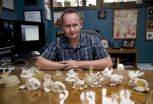Notre Dame research could provide new insights into tuberculosis and other diseases
2012-09-19
(Press-News.org) Researchers Patricia A. Champion and Matthew Champion from the University of Notre Dame's Eck Institute for Global Health have developed a method to directly detect bacterial protein secretion, which could provide new insights into a variety of diseases including tuberculosis.
The Champions point out that bacteria use a variety of secretion systems to transport proteins beyond their cell membrane in order to interact with their environment. For bacterial pathogens like TB these systems transport bacterial proteins that promote interaction with host cells, leading to virulent disease.
Previously, researchers have relied on methods that have fused enzymes or fluorescent markers to bacterial proteins to identify bacterial genes that are used to export bacterial proteins into host cells. However, these methods can't be used in the analysis of all bacterial secretion systems, which has limited understanding of the mechanisms that bacteria use to interact with host cells.
The Champions developed a modified form of bacterial proteomics using a MALDI-TOF mass spectrometer, which directly detects the proteins from whole-colonies by ionizing them with a laser. This research revealed that the method was able to specifically monitor a specialized form protein secretion, which is a major virulence determinant in both mycobacterial pathogens, such as TB, and Gram-positive pathogens, such as Bacillus and Staphylococcus species.
The Champions demonstrated that this new method is applicable to the study of other bacterial protein export systems that could not be effectively studied under previous methods. Their method could also help in the identification of compounds that can inhibit bacterial protein secretion.
The method's importance can be seen in the fact that there are approximately 2 million fatal TB cases a year, mostly in the developing world. Also, antibiotic resistant strains of TB are appearing increasingly.
The Champions' research findings appeared in the Journal Molecular and Cellular Proteomics. The research was funded by the National Institutes of Health and Notre Dame's Center for Rare and Neglected Diseases and capitalization funds from Notre Dame.
INFORMATION:
END
ELSE PRESS RELEASES FROM THIS DATE:
2012-09-19
VIDEO:
University of Iowa researchers have determined that thigh size in obese people is a reason their hip implants are more likely to fail.
Click here for more information.
University of Iowa researchers have determined that thigh size in obese people is a reason their hip implants are more likely to fail.
In a study, the team simulated hip dislocations as they occur in humans and determined that increased thigh girth creates hip instability in morbidly obese patients (those ...
2012-09-19
A once-promising discovery linking prostate cancer to an obscure retrovirus derived from mice was the result of an inadvertent laboratory contamination, a forensic analysis of tissue samples and lab experiments – some dating back nearly a decade – has confirmed.
The connection, which scientists have questioned repeatedly over the last couple years, was first proposed more than six years ago, when the telltale signature of the virus, known as XMRV, was detected in genetic material derived from tissue samples taken from men with prostate cancer.
Later studies failed ...
2012-09-19
MADISON — Pacifiers may stunt the emotional development of baby boys by robbing them of the opportunity to try on facial expressions during infancy.
Three experiments by a team of researchers led by psychologists from the University of Wisconsin–Madison tie heavy pacifier use as a young child to poor results on various measures of emotional maturity.
The study, published today by the journal Basic and Applied Social Psychology, is the first to associate pacifiers with psychological consequences. The World Health Organization and American Academy of Pediatrics already ...
2012-09-19
Writer: Emil Venere, 765-494-4709, venere@purdue.edu
Source: Bedrich Benes, 765-496-2954, bbenes@purdue.edu
Related websites:
Bedrich Benes: http://www.tech.purdue.edu/CGT/Faculty-And-Staff/index.cfm?dept=Computer%20Graphics%20Technology&id=120
IMAGE CAPTION:
Bedrich Benes, an associate professor of computer graphics at Purdue University, is working with Advanced Technology Labs of Adobe Inc. to develop a computer program that automatically strengthens objects created using 3-D printing. The innovation is needed because the printed fabrications are often fragile ...
2012-09-19
Inflammation is the hallmark of many human diseases, from infection to neurodegeneration. The chemical balance within a tissue is disturbed, resulting in the accumulation of reactive oxygen species (ROS) such as hydrogen peroxide, which can cause oxidative stress and associated toxic effects.
Although some ROS are important in cell signaling and the body's defense mechanisms, these chemicals also contribute to and are indicators of many diseases, including cardiovascular dysfunction. A non-invasive way of detecting measurable, low levels of hydrogen peroxide and ...
2012-09-19
MADISON -- Among his many qualities, the pioneering wildlife ecologist Aldo Leopold was a meticulous taker of field notes.
Rising before daylight and perched on a bench at his Sauk County shack in Depression-era Wisconsin, Leopold routinely took notes on the dawn chorus of birds. Beginning with the first pre-dawn calls of the indigo bunting or robin, Leopold would jot down in tidy script the bird songs he heard, when he heard them, and details such as the light level when they first sang. He also mapped the territories of the birds near his shack, so he knew where the ...
2012-09-19
HOUSTON – (Sept. 18, 2012) – Contrary to the prevailing theories that music and language are cognitively separate or that music is a byproduct of language, theorists at Rice University's Shepherd School of Music and the University of Maryland, College Park (UMCP) advocate that music underlies the ability to acquire language.
"Spoken language is a special type of music," said Anthony Brandt, co-author of a theory paper published online this month in the journal Frontiers in Cognitive Auditory Neuroscience. "Language is typically viewed as fundamental to human intelligence, ...
2012-09-19
Although depression and prejudice traditionally fall into different areas of study and treatment, a new article suggests that many cases of depression may be caused by prejudice from the self or from another person. In an article published in the September 2012 issue of Perspectives on Psychological Science, a journal of the Association for Psychological Science, William Cox of the University of Wisconsin-Madison and colleagues argue that prejudice and depression are fundamentally connected.
Consider the following sentence: "I really hate _____. I hate the way _____ look. ...
2012-09-19
While wave watching is a favorite pastime of beachgoers, few notice what is happening in the shallowest water. A closer look by two University of Colorado Boulder applied mathematicians has led to the discovery of interacting X- and Y-shaped ocean waves that may help explain why some tsunamis are able to wreak so much havoc.
Professor Mark Ablowitz and doctoral student Douglas Baldwin repeatedly observed such wave interactions in ankle-deep water at both Nuevo Vallarta, Mexico, and Venice Beach, Calif., in the Pacific Ocean -- interactions that were thought to be very ...
2012-09-19
ANN ARBOR, Mich. — A small subset of patients with open-angle glaucoma (OAG) account for a large proportion of all glaucoma-related charges in the United States, according to new data published by researchers at the University of Michigan Kellogg Eye Center and Washington University, St. Louis.
These findings have importance for future evaluations of the cost-effectiveness of screening and treatment for glaucoma.
"We've identified risk factors associated with patients who are the costliest recipients of glaucoma-related eye care," says Joshua D. Stein, M.D., M.S., ...
LAST 30 PRESS RELEASES:
[Press-News.org] Notre Dame research could provide new insights into tuberculosis and other diseases



